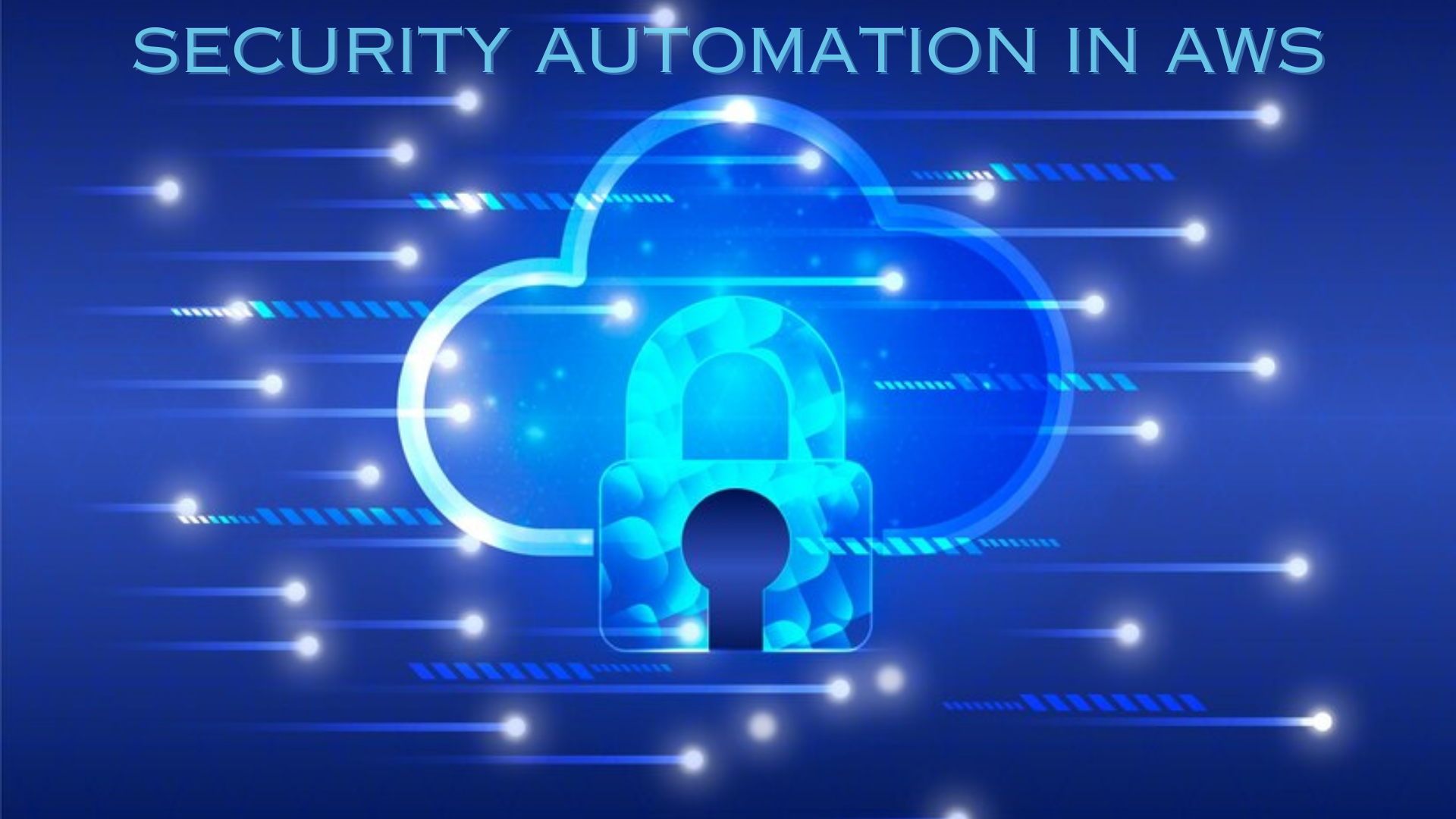Security Automation in AWS: A New Era of Digital Defense
 Ena Vaghela
Ena Vaghela
In today's digital age, the proliferation of data and the increasing sophistication of cyber threats have made security a paramount concern for organizations worldwide. As businesses migrate to the cloud, securing their environments becomes even more critical. Amazon Web Services (AWS), a leader in the cloud computing space, offers robust security features. However, the complexity and scale of cloud environments necessitate a proactive and automated approach to security. Enter security automation in AWS—an innovative solution transforming how organizations protect their digital assets.
The Need for Security Automation
Traditional security measures often rely on manual processes and human intervention, which can be slow and prone to errors. In the dynamic and expansive world of cloud computing, these traditional methods are no longer sufficient. Security automation addresses these challenges by leveraging automation tools and practices to identify, mitigate, and respond to security threats in real time.
Key drivers for security automation include:
Scalability: As cloud environments grow, managing security manually becomes impractical. Automation ensures consistent security practices across a vast number of resources.
Speed: Automated responses to security threats can significantly reduce the time to detect and mitigate incidents, minimizing potential damage.
Accuracy: Automation reduces the risk of human error, ensuring more reliable and consistent security measures.
Efficiency: Automated security processes free up valuable human resources, allowing security teams to focus on strategic initiatives rather than routine tasks.
Core Components of AWS Security Automation
AWS provides a comprehensive suite of tools and services designed to facilitate security automation. These tools span various aspects of security, including identity and access management, threat detection, compliance, and incident response. Let's explore some of the core components:
1. Identity and Access Management (IAM)
IAM is the cornerstone of AWS security, enabling administrators to control access to AWS resources. AWS IAM allows for the creation of users, groups, and roles with specific permissions. Automation tools can help manage these identities, enforce policies, and ensure that least privilege principles are consistently applied.
- AWS IAM Access Analyzer: This tool helps identify resources that are shared with external entities, providing insights into potential security risks. Automating IAM Access Analyzer can continuously monitor and alert administrators about unintended access.
2. Threat Detection and Monitoring
Effective threat detection is crucial for identifying and responding to potential security incidents. AWS offers several services that automate the detection of suspicious activities.
Amazon GuardDuty: This managed threat detection service continuously monitors for malicious or unauthorized behavior. By integrating GuardDuty with automated workflows, organizations can ensure real-time responses to threats.
AWS Security Hub: This service provides a comprehensive view of security alerts and compliance status across an AWS environment. Security Hub aggregates findings from various AWS services and third-party tools, enabling automated response actions through integration with AWS Lambda and Step Functions.
3. Compliance and Governance
Maintaining compliance with regulatory requirements and industry standards is a significant challenge for organizations. AWS provides tools to automate compliance checks and enforce governance policies.
AWS Config: This service enables continuous monitoring and assessment of resource configurations. AWS Config rules can be automated to check for compliance with predefined policies, ensuring that resources remain in a compliant state.
AWS CloudTrail: This service records AWS API calls, providing a detailed audit log of all actions within an AWS environment. Automating the analysis of CloudTrail logs can help detect unusual activities and ensure compliance with security policies.
4. Incident Response
When a security incident occurs, a swift and effective response is critical. AWS offers tools that automate incident response processes, minimizing the impact of security breaches.
AWS Lambda: This serverless compute service allows for the execution of code in response to events. By integrating Lambda with security services, organizations can automate incident response actions such as isolating compromised resources or notifying administrators.
AWS Step Functions: This service enables the orchestration of workflows, making it ideal for automating complex incident response procedures. Step Functions can coordinate multiple AWS services to execute a sequence of actions in response to security incidents.
Best Practices for Implementing Security Automation in AWS
Implementing security automation in AWS requires careful planning and adherence to best practices. Here are some key considerations:
1. Define Clear Security Policies
Establishing clear and comprehensive security policies is the foundation of effective security automation. These policies should outline acceptable use, access controls, incident response procedures, and compliance requirements. Automated tools can then enforce these policies consistently across the environment.
2. Leverage AWS Native Services
AWS provides a rich ecosystem of security services designed to integrate seamlessly with each other. Leveraging these native services ensures that security automation workflows are efficient and reliable. Additionally, native services benefit from AWS's continuous updates and improvements.
3. Implement Continuous Monitoring and Auditing
Continuous monitoring is essential for maintaining a secure cloud environment. Automated tools should continuously monitor resource configurations, network traffic, and user activities. Regular audits of these activities help identify potential security gaps and ensure compliance with security policies.
4. Automate Incident Response
Developing automated incident response workflows is crucial for minimizing the impact of security breaches. These workflows should include predefined actions such as isolating affected resources, notifying administrators, and initiating forensic investigations. Regularly testing and updating incident response workflows ensures their effectiveness in real-world scenarios.
5. Foster a Culture of Security
Security is not just the responsibility of the IT or security team; it is a shared responsibility across the organization. Fostering a culture of security involves educating employees about security best practices, promoting awareness of potential threats, and encouraging proactive reporting of suspicious activities. Automation can support this culture by providing continuous training and awareness programs.
Real-World Examples of Security Automation in AWS
Several organizations have successfully implemented security automation in their AWS environments, reaping significant benefits in terms of security posture and operational efficiency. Here are a few real-world examples:
1. Financial Services Firm
A leading financial services firm leveraged AWS security best practices to enhance its threat detection and response capabilities. By integrating Amazon GuardDuty with AWS Lambda, the firm automated the process of isolating compromised instances and notifying administrators. This automation reduced the mean time to respond (MTTR) to security incidents from hours to minutes.
2. E-commerce Company
An e-commerce company faced challenges in maintaining compliance with industry standards. By implementing AWS Config and AWS Security Hub, the company automated compliance checks and centralized security monitoring. This automation ensured continuous compliance and provided real-time visibility into the security status of their environment.
3. Healthcare Provider
A healthcare provider implemented security automation to protect sensitive patient data. By using AWS IAM Access Analyzer and AWS CloudTrail, the provider automated the detection of unauthorized access and unusual activities. This automation enhanced the provider's ability to safeguard patient data and comply with healthcare regulations.
The Future of Security Automation in AWS
As cyber threats continue to evolve, the need for robust and automated security measures will only grow. The future of security automation in AWS promises even greater advancements, driven by emerging technologies and innovative approaches.
1. Artificial Intelligence and Machine Learning
AI and machine learning (ML) are poised to play a significant role in the future of security automation. These technologies can analyze vast amounts of data to identify patterns and anomalies that may indicate security threats. AWS's AI and ML services, such as Amazon SageMaker, can be integrated with security automation workflows to enhance threat detection and response capabilities.
2. Zero Trust Security Model
The zero trust security model, which assumes that no entity—inside or outside the network—can be trusted by default, is gaining traction. Implementing a zero-trust model requires continuous verification of identities and strict access controls. Security automation can enforce zero trust principles by continuously monitoring and validating access requests.
3. Automated Remediation
Future advancements in security automation will focus on automated remediation, where security issues are not only detected but also automatically resolved. This approach minimizes the need for human intervention and ensures that security vulnerabilities are addressed promptly.
Conclusion
Security automation in AWS represents a paradigm shift in how organizations protect their cloud environments. By leveraging automation tools and practices, businesses can achieve greater scalability, speed, accuracy, and efficiency in their security operations. As cyber threats continue to evolve, security automation will play a crucial role in safeguarding digital assets and ensuring compliance with regulatory requirements.
The journey towards security automation requires careful planning, adherence to best practices, and a commitment to fostering a culture of security. By embracing these principles and leveraging the robust security features offered by AWS Migration Consultant, organizations can navigate the complexities of the cloud with confidence and resilience. The future of security automation is bright, promising innovative solutions and enhanced capabilities to meet the ever-changing threat landscape.
Subscribe to my newsletter
Read articles from Ena Vaghela directly inside your inbox. Subscribe to the newsletter, and don't miss out.
Written by
